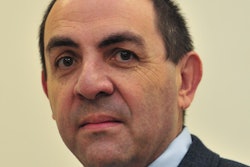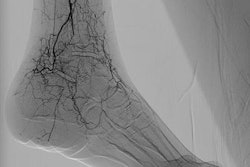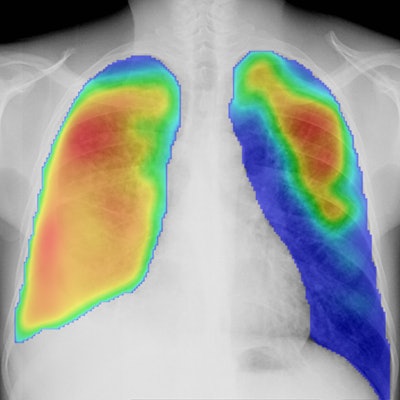
Radiography may be medical imaging's oldest modality, but it's getting a refresh thanks to a wide range of new technologies on display at this week's ECR. The most significant of the techniques is artificial intelligence (AI), but other advances include tomosynthesis and dual-energy imaging.
AI has practically taken over all aspects of radiology since bursting on the scene just a few short years ago. While the technology has applications across all modalities, its use is especially exciting in x-ray, for a variety of reasons.
For one, a number of large, anonymized databases of radiography images have been made available on which AI developers can train and test their algorithms. Second, x-ray is often used as an entry-level modality that's the first to image patients, producing a large volume of images that are frequently difficult to interpret. And radiography is often the only imaging modality available in some locations like developing countries that often have a shortage of radiologists. In these cases, AI could provide an initial interpretation that can triage cases that should be sent on to a human for review.
Meanwhile, tomosynthesis is intended to overcome a historical problem with projection x-ray -- the fact that structures can overlap each other on images, making it more difficult to visualize pathology. Tomosynthesis solves this problem by replacing the stationary tube head of a traditional radiography system with a tube head that moves across the patient in an arc, acquiring a series of images that can then be reconstructed into 3D volumes. These volumes can then be interrogated by radiologists, enabling them to "see around" structures to focus on a region-of-interest.
Experts believe that tomosynthesis could occupy a position in the clinical workup of patients between conventional radiography and more advanced modalities such as CT, being used to analyze suspicious structures like lung nodules. In such a scenario, tomosynthesis would offer an option at a lower radiation dose and lower cost.
GE Healthcare is emphasizing AI applications for radiography at its ECR stand. The company has bundled a number of advanced AI tools into Critical Care Suite, a package of AI algorithms available on its Optima XR240amx mobile radiography system.
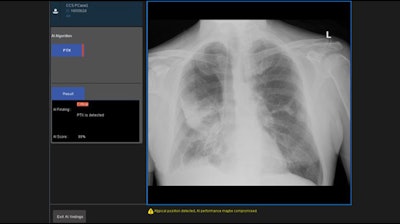 GE's Critical Care Suite is available on the Optima XR240amx mobile radiography system.
GE's Critical Care Suite is available on the Optima XR240amx mobile radiography system.The package is designed to enable users to triage patients quickly and prioritize exams that need immediate attention. For example, it flags images of patients with suspected pneumothorax, speeding radiologist review of these images by up to eight hours, according to the vendor. Other tools are designed to autorotate images or detect image acquisition errors.
Canon Medical Systems is giving ECR 2020 attendees at look at digital radiography (DR) technology available through its subsidiary, Delft Imaging Systems, where a major focus is on developing software for tuberculosis (TB) screening, such as the CAD4TB computer-aided detection (CAD) application.
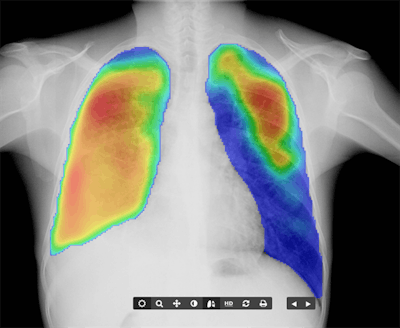 Delft's CAD4TB algorithm is trained to detect tuberculosis on radiography exams. Image courtesy of Delft/Canon.
Delft's CAD4TB algorithm is trained to detect tuberculosis on radiography exams. Image courtesy of Delft/Canon.Although the World Health Organization has recommended systematic tuberculosis screening, many local regions lack the local expertise to read TB images, and thus incidence of the disease has not declined. CAD4TB can help by automatically detecting signs of TB for individuals who can then be sent on for additional definitive tests like the GeneXpert diagnostic assay.
CAD4TB is an algorithm that's been trained to detect pathology that's indicative of TB, such as diffuse textural patterns, focal patterns, and pleural-related abnormalities. The algorithm scans patient images and provides clinicians with a score that indicates the likelihood that a patient is infected with TB. Some 3 million people around the world have been scanned with CAD4TB, according to Canon.
Agfa HealthCare is launching a tomosynthesis capability for its DR 600 and DR 800 room-based radiography systems. DR 600 is a ceiling-based system designed for high throughput, while DR 800 is a flexible system that performs both static radiography and dynamic fluoroscopy exams.
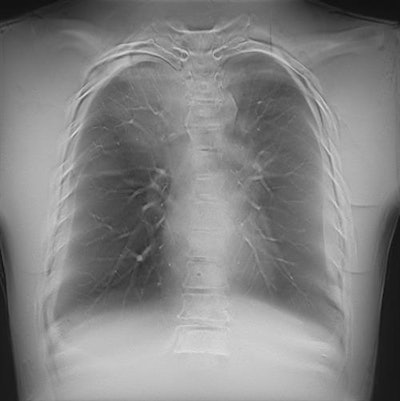 Digital tomosynthesis systems acquire a series of images to overcome the problem of overlapping structures. Image courtesy of Agfa HealthCare.
Digital tomosynthesis systems acquire a series of images to overcome the problem of overlapping structures. Image courtesy of Agfa HealthCare.On DR 800, Agfa's tomosynthesis technology captures no fewer than 46 low-dose images in a 30° arc around the patient, and in just 10 seconds. Image reconstruction takes just 30 seconds. Agfa sees the feature as useful for visualizing microfractures in orthopedics, nodules in pulmonology, and kidney stones in urology. Tomo images can also be processed with Agfa's Musica software.
The company is also introducing the European market to DR 100s, a new mobile digital radiography system. The system is motor-driven and measures just 58-cm wide for easier maneuvering in tight hospital corridors; its FreeView collapsible telescoping column also helps squeeze through tight spaces. Other features include Agfa's ZeroForce technology to make it easier to move the tube head manually, and the company's Musica's acquisition workstation with a 22-inch monitor and built-in security features to keep patient data safe.
Tomosynthesis is a highlight in the ECR stand of Carestream Health. In late 2019, the company launched the technology as an option for its DRX-Evolution Plus x-ray room. Carestream plans to roll out tomosynthesis along with dual-energy imaging, another advanced radiography technique, that enables both high- and low-energy images to be acquired to emphasize either soft tissue or bone, depending on the type of study being conducted.
Other Carestream ECR highlights include the DRX-Revolution and DRX-Revolution Nano mobile x-ray systems; the latter sports a compact, ultralightweight design for imaging in small rooms and critical care units. Carestream's family of DRX detectors on display can be shared across systems and include the new DRX Plus 2530C and Focus 35C detectors, along with the DRX-Transportable System/Lite tablet.
Siemens Healthineers is exhibiting a range of new technologies for its x-ray systems, such as new optimization modes for musculoskeletal imaging on its Multitom Rax system, including a Smart Orbital Lateral mode. The company's Multix Impact floor-mounted DR system has received a new digital detector, as well as a new dual-detector configuration that includes one wireless detector and one in a wall stand. The company is also demonstrating the ability to control Multix Impact with a tablet computer, in addition to traditional controls at the x-ray tube head.
Mobile C-army developer Ziehm Imaging is showcasing its line of mini-C-arms and hybrid operating room suites. The company has long been a pioneer of mobile C-arms with flat-panel digital detectors, and most recently has been introducing C-arms using detectors based on complementary metal-oxide semiconductor (CMOS) material, such as its Ziehm Vision RFD Hybrid Edition/3D system.
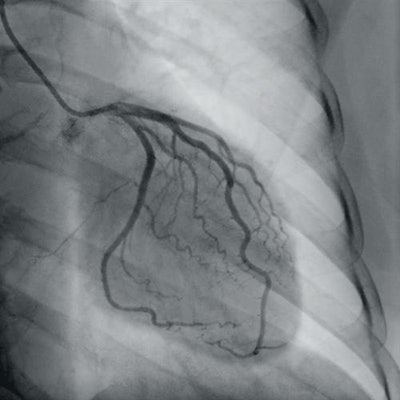 Ziehm has introduced C-arms based on complementary metal-oxide semiconductor technology.
Ziehm has introduced C-arms based on complementary metal-oxide semiconductor technology.Ziehm is highlighting software features and tools for different clinical applications, such as orthopedic, spine, trauma, and cardiovascular use. The company at ECR 2020 is also discussing its concept for a mobile cardiac cath lab.
In addition to showcasing its low-dose DR system for musculoskeletal applications, EOS is discussing StereoView, a 2D/3D viewer designed to enhance clinical collaboration and patient engagement. The viewer enables the visualization of 3D models and clinical parameters to improve the discussion of diagnostic and treatment options with patients, and to facilitate exchange with referring physicians.
The company is also demonstrating its certified online training program, sterEOS 2D/3D modeling and analysis application, and EOSapps 3D surgical planning software for spine, hip, and knee applications.
Under the REiLI brand, Fujifilm is displaying AI solutions that support workflow, including the Lunit Insight CXR-MCA AI software for the FDR nano, the company's compact digital x-ray cart.
Samsung | NeuroLogica is demonstrating the GC85A ceiling-suspended radiography system, which includes its S-Vue technology for reconstructing high-quality low-dose images. The company is also highlighting GM85, a mobile radiography system that is designed for easy maneuverability in narrow hallways and elevators.
Originally published in ECR Today on 11 March 2020.
Copyright © 2020 European Society of Radiology




